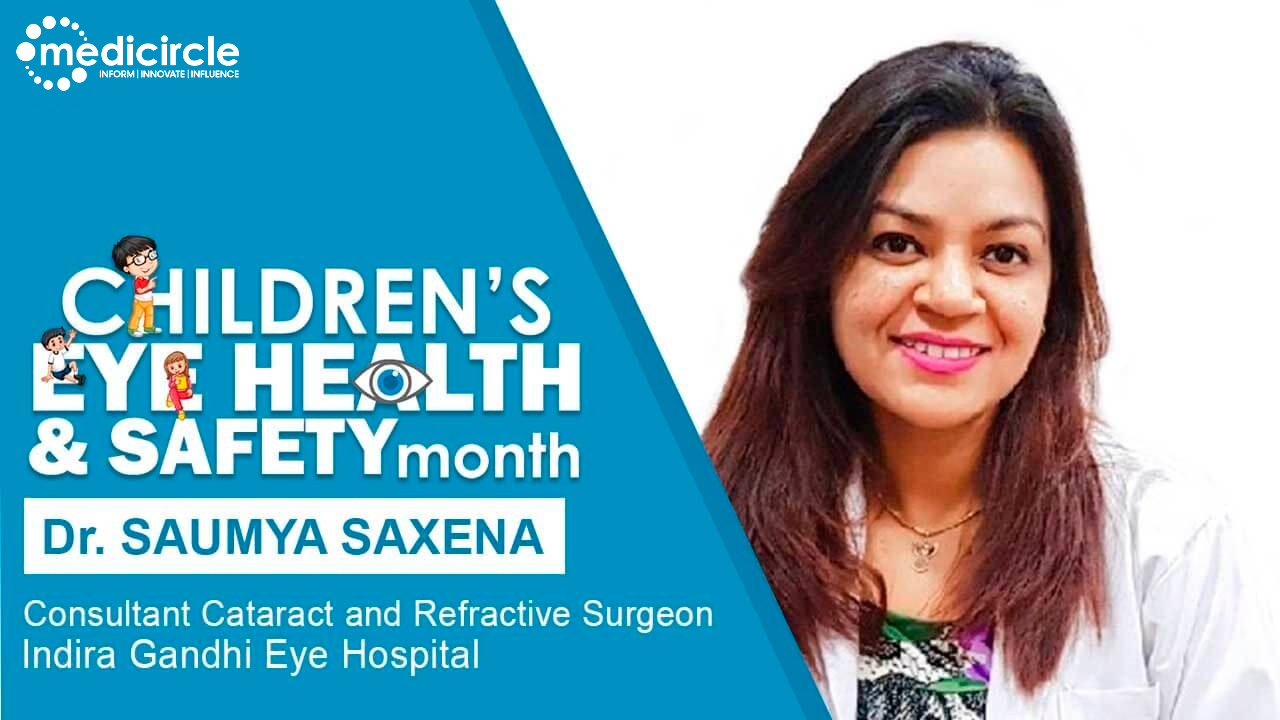The month of August is dedicated to preventing eye injuries and vision loss amongst children. One out of 20 children between ages 3-5 has a vision problem that could result in permanent vision loss if left untreated. According to India TV, only 46% of Indian kids get their regular eye test done. One factor is air pollution which causes excessive rubbing of the eyes resulting in weak vision. Hereditary is the root cause for kids suffering from myopia (far-sightedness) which can affect their performance and development in the long run. 23 to 30% of children suffer from myopia, especially urban-dwelling kids, as they spend less time under sunlight. We at Medicircle are conducting a series on Children's Eye Health and Safety Awareness Month, to help raise awareness about eye diseases and conditions found in children and learn how to prevent them.
Dr Saumya Saxena is a Consultant in cataract and refractive surgery in Indira Gandhi Eye Hospital. She was a consultant at QRG Medicare. In her seven-plus years of career, she has performed over 10,000 cataract surgery and more than 1000 refractive surgery procedures. She's among the few ophthalmologists who perform aesthetic botox injections certified by the American Academy of Aesthetics of Physicians.
Common eye problems in kids
She says, “The most common eye problem amongst kids we come across regularly is refractive errors. This causes blurring of vision and can be easily corrected by wearing spectacles. Another one is amblyopia, which is known as lazy eye. In this, a child can have trouble seeing at near distance, far distance or both. If the child does not see directly for long enough they can lose vision and get a lazy eye. The third problem is strabismus, which we commonly know as squint. In this, there is a misalignment of eyes and nothing more. Other less common eye problems are watering of eyes since birth, allergies and conjunctivitis. Another loss would be the drooping of eyelids and some nutritional deficiencies.”
Common symptoms of eye problems
She lends, “Constant eye blinking or eye rubbing due to allergies or refractive errors are the most common symptoms that parents come across in their child. A child is less likely to tell you that they have blurry vision. There are some obvious signs of childhood vision problems. It could be a quick loss of interest in regular activities which require extensive eye use. For instance, the child would be reading and suddenly they lose interest. So if you closely pay attention to the symptoms in a child, you will be able to sooner get an eye appointment with an ophthalmologist. Oftentimes, a parent does not come up with signs of strabismus, amblyopia or refractive errors. That is why it is important to have a regular eye screening in these critical years of growth. When we talk about refractive errors, there are three main refractive errors. They are hyperopia, myopia and amblyopia. Hyperopia is commonly known as farsightedness, where the child is able to see distance but cannot read pretty well. Then there is myopia, where the child is able to read well but is not able to see the distance. Then there is astigmatism where both the near and far visions are blurry. In the case of amblyopia, the child gets a lazy eye in spite of getting the vision corrected. Then there is strabismus, where the child may look straight ahead, but the eyes might go up, down or turn to the other side. The basic need for a healthy vision is that both eyes should work together.”
Development of Eyesight in kids
She explains, “Let's start from the beginning. The initial year of the child is very important. The parents should be aware of what they need to check in the child as they grow older. Initially, the baby should be able to focus and follow objects. This is the first sign that the parent should check when their baby is three months old. Around five months old the baby should be able to perceive depth. For instance, they are able to reach out to objects and hold them properly. Around nine months of age, they should be able to recognise colours and reach out for different colours. These are the health tips, which basically tells the parent that the child is growing well and the visual health is good enough. Of course, by the age of one or two years, the child is able to recognise objects. And by two years and above, the vision is almost 6/6 and that can be easily dealt with through paediatric charts that we have. So, I'm stressing over this fact again and again that you need to have regular eye checkups for kids. When the baby turns three months old, parents should start analysing signs to help know about their visual wellbeing.”
Diet for healthy eye vision in children
She stresses, “Yes, diet plays a big role in vision development. A healthy meal contains lots of vitamins and minerals that are required for the development of the eye and the retina. So we start off with the green leafy vegetables which kids usually hate having. Like kale and cabbage. They are rich in lutein and zeaxanthin. They are antioxidants that help develop your retina. Then foods like fish, which are rich in omega-three fatty acids. Egg yolk contains Vitamin A which is good for your eyes. Almonds contain vitamin E that is good for your ocular surface. Then dairy products like milk and curd which is again a good source for vitamin A and zing. So vitamin A helps in the proper development of eye pigments and zinc helps in the development of the retina. Then there are citrus fruits, which are pretty rich in vitamin C, which is basically good for your cornea healthy. So yes, nutritional food has got a major role in your eye development.”
(Edited by Priyal Shah)

 Learn from Dr Saumya Saxena the clues you need to check whether your child has any vision problems or not. She shares healthy and nutritious foods to eat, that will surely boost your child's vision.
Learn from Dr Saumya Saxena the clues you need to check whether your child has any vision problems or not. She shares healthy and nutritious foods to eat, that will surely boost your child's vision.




.jpeg)
_(1).jpeg)
_(1)_(1)_(1).jpeg)


.jpeg)
.jpeg)
.jpeg)







.jpeg)

.jpeg)





.jpeg)
.jpeg)

.jpeg)
